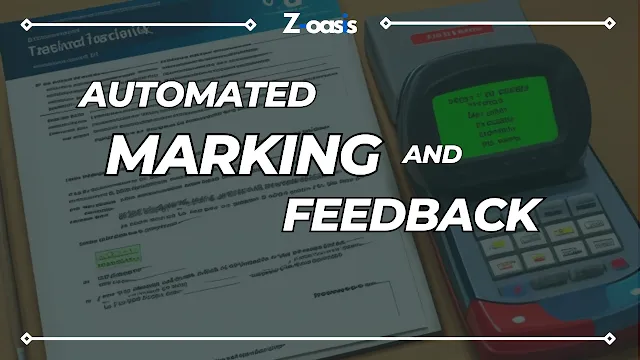Explore the ever-evolving journey of artificial intelligence in education, where Automated Marking is skimming through our textbooks and making a lasting impression.
 |
| Automated Marking and Feedback An AI Adventure |
1. Embracing the Digital Marker
A revolution is quietly brewing in the world of education, spurred on by advancements in artificial intelligence. What once required hours of tedious effort - Marking students' work and delivering feedback - has seen a digital makeover. The emergence of AI has reinvented this process, bringing about a heightened level of efficiency and effectiveness.
2. Why We Need to Automate Marking
Remember how important it was to receive a well-graded assignment back in school, to see the red marks, and to note where improvements could be made? Feedback is a key step in the learning journey, allowing students to acknowledge their strengths and address their weaknesses. However, it's often, let's face it, quite a daunting task - and downright difficult when faced with large classes or complex assignments. That's where Automated Marking steps in, powered by AI technologies like natural language processing and machine learning. By analyzing and evaluating learners' work in real-time, this technology doesn't just save valuable time for educators but also ensures students are quickly guided in the right direction.
3. Inside the Digital Classroom: How Automated Marking Functions
Endowed with a set of predefined criteria, Automated Marking systems use algorithms to evaluate students' work. Aspects like accuracy, structure, completeness, and guidelines adherence are taken into account. The algorithms then delve into the student's submissions, comparing their output with a set of predefined responses or models.
But wait, how precisely does this happen? To accurately grade assignments, the system employs various tactics. For instance, a specific subset of AI called 'Natural Language Processing' (NLP) enables the system to dissect the language used in written submissions, checking everything from grammar to syntax and sentence construction. And then there's machine learning - it's like a sponge that soaks up information from a wide dataset of previously graded assignments and uses it to predict the assignment's quality.
4. The Gift of Time and Fairness: Benefits of Automated Marking
The integration of Automated Marking in education isn't just about high-tech solutions. It provides tangible, practical perks for both educators and students.
Educators: An Aid In Efficiency
Firstly, it gives back time - the precious commodity educators don't have enough of. Automating Marking means they are no longer bogged down with manual Marking and can invest more time in designing engaging and customized learning experiences.
Students: Timely and Fair Feedback
Meanwhile, it assures students of almost instant feedback. The ability to review their performance almost immediately helps them to learn from their mistakes quickly, supports ongoing learning, and allows them to progress at their preferred pace.
Unbiased Evaluation
In the world of AI, no room for bias or prejudices may inadvertently creep into human Marking. Automated Marking systems consistently stick to their objective assessment criteria, making sure all students are evaluated fairly.
Education for All, One Assignment at a Time
Scalability is the ultimate strength of Automated Marking. Catering to both large-scale classroom settings and online learning environments, AI can handle a bulk of assignments and provide feedback to hundreds, if not thousands, simultaneously.
5. A Word of Caution: Automated Marking Isn't Perfect
Despite the numerous benefits Automated Marking systems bring, they aren't without limitations:
The Challenge of Subjectivity
AI can falter when it comes to subjective or creative assignments like essays, art projects, or open-ended questions. They're not yet equipped to appreciate the subtleties of individual perspective or eccentric creativity that such assignments often require.
AI vs Context
Another challenge that AI faces is understanding context. It may trip over-interpreting elements like sarcasm, irony, or cultural nuances in written work. To overcome this, educators may need to employ a hybrid approach – Automated Marking supplemented by human judgment.
The Balance Between AI and Human Interaction
There's a risk of developing an over-reliance on technology, thereby hampering human interaction and personalized feedback, which are such crucial aspects of the learning journey. It is essential to maintain a balanced approach, where technology and human touchpoints coexist in harmony.
6. The Road Ahead: Future Awaits
The future promises intriguing advancements in Automated Marking and feedback systems. Can you imagine a system that identifies plagiarism or one that can align Marking criteria to specific learning outcomes? What about a tool that provides detailed, personalized suggestions for growth? Or better still, an autonomous Marking system fully integrated into our educational workflows? Fasten your seatbelts because we're heading into a fascinating future of education, thanks to AI. The capabilities of AI are ever-growing, and as such, its potential to transform education cannot be overstated. After all, adapting these advancements will surely be instrumental in refining our teaching and learning environment, providing real-time feedback and insights to educators and students alike.